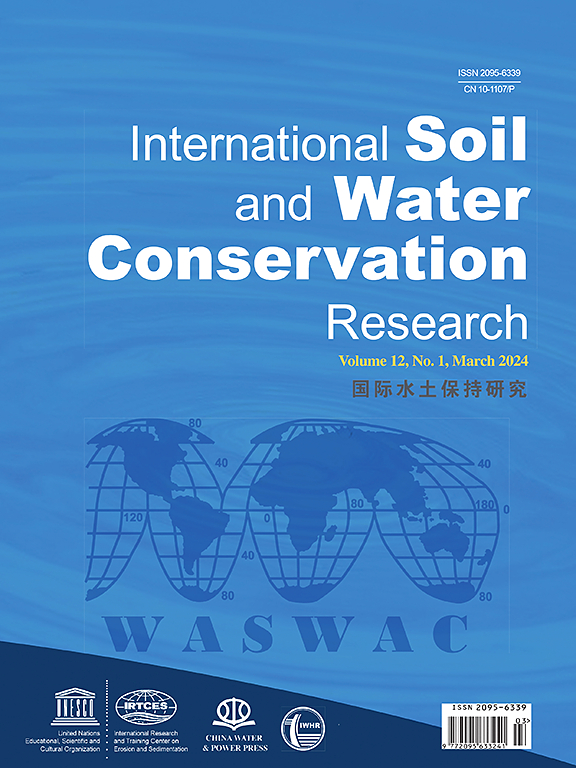Influence of post-fire root decay-induced soil macropores on slope stability: A new method for analyzing heterogeneous slope stability
IF 7.3
1区 农林科学
Q1 ENVIRONMENTAL SCIENCES
International Soil and Water Conservation Research
Pub Date : 2025-03-04
DOI:10.1016/j.iswcr.2025.02.007
引用次数: 0
Abstract
Soil macropores are key factors affecting slope hydrological processes and stability, particularly under heavy rainfall conditions. Although wildfires can lead to the decay and death of plant roots, leaving root channels, few studies have examined temporal variation in the distribution of soil macropores or their impact on slope stability. To address this, we examined the bacterial abundance, root distribution, and macropore characteristics of burnt forest at one week and 6 and 12 months post-fire. Numerical simulation was used to analyze the effects of macropore distribution on slope stability under extreme rainfall conditions (80 mm/d × 4 d) at each time-point. Soil macropores accelerated the propagation of water pressure, potentially triggering shallow-slope instability. In the simulation, following 1 d of rainfall, slope stability was lower, by 3.55% and 8.68%, respectively, at 6 and 12 months than at one week post-fire. Following 4 d of rainfall, slope stability was better at 6 and 12 months than at one week post-fire, by 1.87% and 2.81%, respectively, owing to the drainage effect of the macropores. Even more importantly, this study proposed a method for coupling the spatial heterogeneity of soil macropores with a numerical model of slope stability. These findings help to elucidate the temporal changes in vegetated slope hydrology and stability after a wildfire and provide a reference for the numerical simulation of the stability of heterogeneous slopes.
火灾后根系腐烂引起的土壤大孔隙对边坡稳定性的影响——一种分析非均质边坡稳定性的新方法
土壤大孔隙是影响边坡水文过程和稳定性的关键因素,特别是在强降雨条件下。虽然野火会导致植物根系腐烂死亡,留下根系通道,但很少有研究考察土壤大孔隙分布的时间变化及其对边坡稳定性的影响。为了解决这个问题,我们在火灾后1周、6个月和12个月检测了烧毁森林的细菌丰度、根系分布和大孔特征。采用数值模拟方法分析了各时间点极端降雨条件下(80 mm/d × 4 d)大孔隙分布对边坡稳定性的影响。土壤大孔隙加速了水压力的传播,可能引发浅坡失稳。在模拟中,降雨1 d后,第6个月和第12个月的边坡稳定性分别比火灾后1周降低了3.55%和8.68%。降雨4 d后,由于大孔隙的排水作用,火灾后6个月和12个月的边坡稳定性分别比火灾后1周的稳定性好1.87%和2.81%。更重要的是,本研究提出了一种将土壤大孔隙空间异质性与边坡稳定性数值模型耦合的方法。这些发现有助于阐明森林火灾后植被坡面水文和稳定性的时间变化,为非均质坡面稳定性的数值模拟提供参考。
本文章由计算机程序翻译,如有差异,请以英文原文为准。
求助全文
约1分钟内获得全文
求助全文
来源期刊

International Soil and Water Conservation Research
Agricultural and Biological Sciences-Agronomy and Crop Science
CiteScore
12.00
自引率
3.10%
发文量
171
审稿时长
49 days
期刊介绍:
The International Soil and Water Conservation Research (ISWCR), the official journal of World Association of Soil and Water Conservation (WASWAC) http://www.waswac.org, is a multidisciplinary journal of soil and water conservation research, practice, policy, and perspectives. It aims to disseminate new knowledge and promote the practice of soil and water conservation.
The scope of International Soil and Water Conservation Research includes research, strategies, and technologies for prediction, prevention, and protection of soil and water resources. It deals with identification, characterization, and modeling; dynamic monitoring and evaluation; assessment and management of conservation practice and creation and implementation of quality standards.
Examples of appropriate topical areas include (but are not limited to):
• Conservation models, tools, and technologies
• Conservation agricultural
• Soil health resources, indicators, assessment, and management
• Land degradation
• Sustainable development
• Soil erosion and its control
• Soil erosion processes
• Water resources assessment and management
• Watershed management
• Soil erosion models
• Literature review on topics related soil and water conservation research
 求助内容:
求助内容: 应助结果提醒方式:
应助结果提醒方式:


